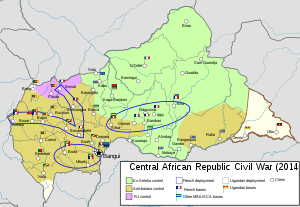MINUSCA
United Nations Multidimensional Integrated Stabilization Mission in the Central African Republic (also called MINUSCA, which is an initialism of its French name Mission multidimensionnelle intégrée des Nations unies pour la stabilisation en Centrafrique) is a UN peacekeeping mission, which started on April 10, 2014, to protect Central African Republic civilians under Chapter VII of the UN Charter. It transformed the 6,000-strong African Union-led peacekeeping force known as MISCA into a UN peacekeeping mission and became operational on September 15, 2014. The UN deployed a transition team to set up MINUSCA and prepare for a seamless transition of authority from MISCA to MINUSCA.[1] As of 2016, it has more than 10,000 troops on the ground. Its role is to:
- support for the Pres process;
- facilitating humanitarian assistance;
- promotion and protection of human rights;
- support for justice and the rule of law;
- disarmament;
- demobilization;
- reintegration;
- repatriation processes.[2]
 | |
| Formation | 10 April 2014 |
|---|---|
| Type | Peacekeeping mission |
| Legal status | Active |
Head | Parfait Onanga-Anyanga (Gabon), Special Representative |
Parent organization | United Nations Security Council |
| Website | minusca |
The current Special Representative of the Secretary-General and head of MINUSCA is Mankeur Ndiaye of Senegal.
The top country contributor for troops and police is Rwanda with 1,369 troops and 438 police officers sent to assist with MINUSCA, followed by Pakistan, sending 1,225 troops and Senegal sending 316 police officers.[3]
History

The Séléka militia staged a rebellion in 2013 that led to the end François Bozizé's regime in the Central African Republic (CAR), due to economic and political. The Séléka's continued heinous crimes in Central African Republic led to worsening conditions in Central African Republic, which then evolved the conflict from government resistance into a religious conflict. Information was later found that the Séléka was a Muslim group committing human rights violations against their predominately Christian country. A Christian militia then formed, calling themselves the Anti-Balaka, to fight against the Séléka.[4] The Central African Republic began to weaken as the conflict continued, with an incline in mortality and a decline in life expectancy, which attributed to increasing rates of preventable and treatable diseases. The conflict also resulted in 320,000 people fleeing to neighboring countries, including Chad and Democratic Republic of Congo, and as of 2017, left approximately 600,000 people internally displaced.[5]
Present
In 2015, a battalion from the Armed Forces of the Democratic Republic of the Congo (FARDC), numbering 807 personnel, was deployed to the CAR as part of MINUSCA. The DRC also deployed 118 police. In August 2015, allegations surfaced that three DRC soldiers had raped three young women in the town of Bambari, northeast of the capital Bangui. Allegations of child sexual exploitation and abuse were also made.[6] In January 2016, it was announced that the battalion would be repatriated, as it had failed to meet UN "vetting and preparedness" requirements.[7]
In recent attacks taken place in CAR in April 2018, MINUSCA and government forces initiated an operation that would disarm a militia, that was predominately Muslim, in Bangui's peacekeeping 5 district, which is also where Christians were majority. MINUSCA is challenged to attain the mandate in protecting human rights and disarming and dismantling non state actors due to the lack of infrastructure resistance in using military force.[8]
As the mandate for MINUSCA has been extended and amended on November 15, 2019, to fit the needs to support the Central African Armed Forces (FACA), there will be difficulty considering the lack of infrastructure and resources.[9] The update to the mandate also includes for MINUSCA to assist the electoral process for a peaceful transition for president and legislative body by providing good offices, security, operational, logistical, and technical support for the election.[10]
In the Peacekeeping Budget, MINUSCA receives 14% of the budget, with a total of $930,211,900 as of 2018–2019.[11]
References
- "The UN Peacekeeping Mission in the Central African Republic". Archived from the original on 22 December 2014. Retrieved 1 December 2014.
- "United Nations Multidimensional Integrated Stabilization Mission in the Central African Republic". United Nations. Retrieved 1 December 2014.
- "MINUSCA". United Nations Peacekeeping. Retrieved 2019-11-17.
- Fitriyah, Fitriyah (2018-08-29). "Politik Dinasti Pada Kandidasi Perempuan Dalam Pilkada Serentak 2015 di Jawa Tengah". Jurnal Ilmu Sosial. 17 (1): 39. doi:10.14710/jis.17.1.2018.39-52. ISSN 2548-4893.
- "Africa :: Central African Republic — The World Factbook - Central Intelligence Agency". www.cia.gov. Retrieved 2019-12-03.
- MINUSCA, "New Allegations of Sexual Abuse Emerge Against MINUSCA Peacekeepers," press release, February 4, 2016, cited in Shemalla, Paul; Tomb, Nicholas (2017). Security forces in African states : cases and assessment. Amherst, NY: Cambria Press. p. 56.
- "UN pulls DRC troops from Central Africa mission". News24. 2016-01-08. Retrieved 2019-11-11.
- "Violence in the Central African Republic". Global Conflict Tracker. Retrieved 2019-12-04.
- "New MINUSCA Leadership Must Seize Opportunity for Progress in the Central African Republic". Refugees International. Retrieved 2019-12-04.
- "MINUSCA Mandate Renewal : What's In Blue". www.whatsinblue.org. Retrieved 2019-12-04.
- "Central African Republic (MINUSCA)". Better World Campaign. Retrieved 2019-12-03.